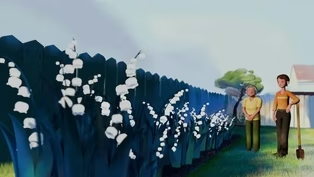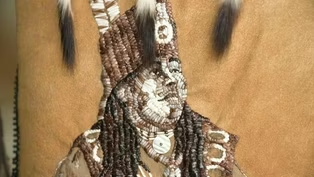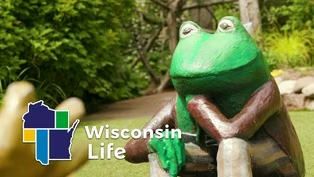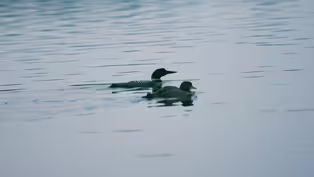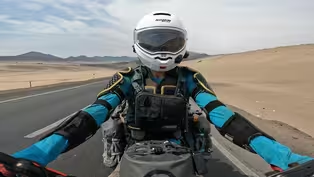
Sheboygan's Bookworm Gardens
Season 12 Episode 3 | 26m 48sVideo has Closed Captions
Stories come to life at Bookworm Gardens in Sheboygan, a literary botanical oasis.
Host Angela Fitzgerald visits Bookworm Gardens in Sheboygan, a whimsical botanical garden space where beloved children’s books come to life. Hop on the “Little Blue Truck,” board “The Magic School Bus,” discover “Where the Wild Things Are” or dive into the world of Dr. Seuss.
Problems playing video? | Closed Captioning Feedback
Problems playing video? | Closed Captioning Feedback
Wisconsin Life is a local public television program presented by PBS Wisconsin
Funding for Wisconsin Life is provided by the Wooden Nickel Fund, Mary and Lowell Peterson, A.C.V. and Mary Elston Family, Obrodovich Family Foundation, Stanley J. Cottrill Fund, Alliant Energy, UW...

Sheboygan's Bookworm Gardens
Season 12 Episode 3 | 26m 48sVideo has Closed Captions
Host Angela Fitzgerald visits Bookworm Gardens in Sheboygan, a whimsical botanical garden space where beloved children’s books come to life. Hop on the “Little Blue Truck,” board “The Magic School Bus,” discover “Where the Wild Things Are” or dive into the world of Dr. Seuss.
Problems playing video? | Closed Captioning Feedback
How to Watch Wisconsin Life
Wisconsin Life is available to stream on pbs.org and the free PBS App, available on iPhone, Apple TV, Android TV, Android smartphones, Amazon Fire TV, Amazon Fire Tablet, Roku, Samsung Smart TV, and Vizio.
Providing Support for PBS.org
Learn Moreabout PBS online sponsorship- Announcer: The following program is a PBS Wisconsin original production.
- Angela Fitzgerald: Coming up on Wisconsin Life: We return to Ashland to see how a world record attempt is going, then meet a researcher in Tomahawk studying... [loon calling] ...loons, a Ho-Chunk artist blending tradition and innovation, and we share an animated story of a grandmother's devotion to her family and flowers.
That's all ahead on Wisconsin Life.
[bright music] - Announcer: Funding for Wisconsin Life is provided by: the Wooden Nickel Fund, Mary and Lowell Peterson, the A.C.V.
and Mary Elston Family, the Stanley J. Cottrill Fund, UW Health, donors to the Focus Fund for Wisconsin Programs, and Friends of PBS Wisconsin.
[water splashing] [bell ringing] - Parent: Oh!
Hi!
- Angela: Once upon a time, there was an enchanted garden full of books that come to life.
It's called Bookworm Gardens, and we're exploring it today on Wisconsin Life.
I'm your host and garden guide, Angela Fitzgerlad.
This sprawling green space in Sheboygan welcomes visitors May through October.
Enter the garden to inch by inch through the caterpillar.
Is it Cloudy with a Chance of Meatballs?
Take a ride on the Magic School Bus.
[horn beeping] Or just touch, read, or play!
Garden Founder Sandy Livermore had the vision to create a space immersed in storytelling and opened the gates in 2010.
And it's continued to grow since.
Now, the nonprofit has a yurt classroom, events for adults, and more than 80 different book gardens.
Taking inspiration from the Lorax garden, let's bookmark it here to travel far and near.
We have many stories yet to appear.
As we head up to Ashland to check back in with a motorcyclist attempting a world record ride.
- Bridget McCutchen: I grew up on a farm in northern Wisconsin.
I like to joke I was raised in a field by cows and a dog.
Part of it's a joke and part of it is reality.
- Angela: In August 2022, Bridget McCutchen set out from Ashland... - Jeff McCutchen: Goodbye, Bridget!
- Angela: ...attempting to set a world record as the youngest person to circumnavigate the world on a motorcycle.
[bright guitar music] - Bridget: I mean, it's a beautiful world, and I wanna go see it.
That's a big part of it, is just wanting to go see the world.
- Angela: Bridget took with her an abundance of curiosity and ambition.
- Bridget: Riding a motorcycle, to me, is the best thing in the world.
And it gives you a sense of freedom and independence.
- Angela: Fourteen months later, [motorcycle revving] with her newfound freedom and independence, Bridget throttled back into the town where the journey began.
[people applauding and cheering] - And we're so happy you're here to celebrate Bridget's return.
- Oh, my goodness!
Okay, well, I'm alive, I'm fine.
I'm excited to rest, and honestly, eat food that's very familiar.
- Angela: At the starting line, no one could have predicted the outcome.
Least of all Bridget, who rewatched the interview she recorded just prior to leaving.
- I think it's going to start out with completing the trip and getting the record, and I would not be surprised by the end of it if it is completely different, because I guarantee you, I will not be the same person when I come back, and my values would have changed.
And so, that's gonna change.
[chuckling] Wow!
[upbeat electronic music] - Angela: After logging about 50,000 miles and traversing 45 countries, Bridget did come back a changed person.
- Bridget: The riding for long hours gave me a lot of time to think.
I think I've become a lot calmer.
I think a lot of things don't bother me the same way they used to.
I am in the desert.
This is the desert I am in.
I feel way more certain of myself than I did previously, and I think that's a big, big deal.
So I've stopped for the night, and this is my camp spot.
- Angela: That's not to say she wasn't uncertain or frightened during the trip.
- There were times when I was scared.
I think fear is very healthy.
It tells you when your situations are dangerous.
- Angela: When asked the driving factor that got her through it all... [Bridget grunting] - Bridget: Stubbornness, mostly.
[laughing] I think that was a huge part of it, is once I get ahold of something, I'm a hold of it and it's not going anywhere.
So, I think just holding onto that idea really kept me going.
[laughing] - Angela: The gravity of her accomplishment is still setting in.
I just thought about that.
Um... Pretty cool.
Y'know, I'm very happy I'm going home, but I'm gonna miss this.
I am going to miss this a whole bunch!
And that I did that was pretty awesome.
I am in Nepal!
For the rest of the winter, sort of be figuring out what I'm doing next.
And, y'know, sort of getting things done.
I wanna go back to working on boats and, like, doing other stuff like that.
I'm not exactly sure, but I have some things in mind.
No big adventures planned yet.
- Angela: Driven to succeed on an adventure that took her to all corners of the world.
- I am in the forest in Germany.
And I really want to inspire other young women like myself to ride motorcycles.
- Angela: Mission accomplished, Bridget!
With an inspiring story that landed her in the Guinness Book of World Records.
[motorcycle engine roaring] Next up, we meet a researcher in Tomahawk heading out on the lake to study an elusive bird.
[loon calling] [loon calling] - Student: There they are, yeah.
- Walter Piper: Good eye.
- Angela: The most important research on Wisconsin's iconic loons happens in the middle of the night.
- Walter: Just another routine night on the lake.
- Angela: From early on, biologist Walter Piper has had a fascination with loons.
- Healthy-looking chick.
[loon chick screeching] There he is, real fuzzy.
Hasn't gotten adult feathers in yet.
I've always been enchanted by loons.
[loon calling] As a child, I heard loons out on the lake, and they were beautiful to listen to.
[loon calling] - Angela: For more than 30 years, Walter has been watching loons during his annual pilgrimage to northern Wisconsin.
- Walter: I really love the solitude of being out on a lake in a canoe, watching loons, being sort of at one with them, watching them raise their families.
[loon calling] - Angela: Walter is a loon behavior and reproduction specialist.
His observations are providing new insights.
- When you see loons preening, after they've done all that combing of the feathers, they'll get up and straighten out their wings by doing a wing flap.
[wings flapping] - Angela: However, the calls that echo across the lakes in the Northwoods are still very much a mystery.
[loon calling] - Walter: We've only begun to scratch the surface about what they're communicating with their calls.
- Angela: Those familiar summer sounds might also fade away.
- There are projections that loons will disappear from Wisconsin in the next several decades.
- Angela: Imagine the eerie silence on northern lakes without loons.
- Walter: I'm very, very anxious about this reproductive decline that we've seen.
Reproductive success is way down.
- Angela: This wasn't the case when Walter first started his loon research in 1993.
- Walter: Back in the roaring '90s, half the pairs would have two chicks.
Now it's about three to one, one-chick broods to two-chick broods.
- Angela: That phenomenon is putting more stress on Walter's research, making his work even more crucial.
- Walter: We're going to three lakes in the Rhinelander area: Flannery, Washburn, and Manson.
[loon calling] Not too far away.
That's promising.
[owl hooting] If we're trying to catch chicks, I'll make a hoot call, which is what the adults do.
It's like the deer in the headlights.
If they hesitate and stay on the surface and they're not sure, then we grab them.
[Walter whistling] Now slow.
[whistling] [splashing] - Angela: The team will take the loons to shore to quickly conduct their research before releasing them back into the wild.
- Walter: We weigh both adults and chicks when we capture them.
That's an important measurement that we make.
And what we've noticed is that chick mass has declined substantially.
- Angela: Walter has a theory on why chick mass continues to decline.
- Walter: Loons are visual predators.
Loons have to be able to see their food to catch it and to feed it to their chicks.
So, water clarity suddenly came onto our radar.
And every time the satellite passes overhead, we can see, how clear is the water in this lake?
Water clarity in northern Wisconsin had declined on average, and this meant that the overall decline had an enormous impact on loons, we realized.
- Angela: Another threat: an explosion of black flies.
- Walter: That's related to rainfall, almost certainly related to climate change.
We've had some almost complete wipe-out years, where all May nests that loons attempt are wiped out.
Loons are just overwhelmed by black flies.
There are thousands around them, and they abandon the nest.
- Angela: The emerging danger to loons is playing out in Walter's research.
- This year, it's about 105 pairs that we follow, most of whom we've marked in previous years.
Some of them, we marked back in the '90s.
Okay, so this bird is green over copper cream.
- Angela: Walter is very familiar with the loons here on Manson Lake in Oneida County.
- Walter: The male is an 11-year-old male.
The female is from Vilas County.
These are both adults banded as juveniles, so they're especially valuable to us 'cause we know their age exactly.
We also know their natal origins, so we can learn a lot about their behavior and ecology throughout their lives.
- Angela: On this night, Walter captures their chick and brings it to shore for banding.
Despite the trends, this baby loon is defying the odds.
- Walter: Got it?
- Allie: Oh, that is a big chick.
- Walter: A big old chick.
I know, a little nipper too.
He's our biggest one by far this year.
- Angela: The chick weighs in at more than 10 pounds.
- It's almost certainly a male, to be that large this young.
It's about something like eight weeks old.
It's just huge.
Okay, that's good.
Pretty, pretty big.
Okay, back in the box he goes, before he nips me to death.
So, a very successful night.
All right, get them back to where they belong.
We breathe sigh of relief when we catch a big, healthy chick like this because it means that it's been well fed.
That says good things about Manson Lake.
It made us feel good to see such a big, strapping male chick.
- Angela: It's hard not to see the heartfelt connection Walter has with these loons.
[loon calling] - I love loons, I love being outdoors.
I don't want to let loons slip away in northern Wisconsin, or at least I wanna do everything I can to try to keep them here because they're beautiful animals and they've given me so much.
[loon calling] - It's always story time at Bookworm Gardens in Sheboygan as we turn the page to uncover a spellbinding world of children's literature.
- Child: Over here!
- Angela: Our story begins with Elizabeth Wieland, Executive Director of the nonprofit botanical garden.
- Elizabeth Wieland: Bookworm's mission is to inspire the love of books and nature in the young and young at heart.
When you think about our mission and you think about young and young at heart, I really believe that we have an incredible experience and inspiration for people of all ages here on this site.
I love it when there are families here and children here.
I also love it when there are adults without children and older individuals.
That's really important to us that we have both.
- Parent: There we go!
- Elizabeth: In many of our exhibits, they play with scale, so you get to feel like you are either incredibly small or incredibly large.
[child exclaiming] - Can you tell us more about the spaces in the gardens?
- Gosh, there are so many spaces.
So in each site, we've taken the book and then interpreted it in some way.
Some of 'em, you're meant to interact with.
You could stick your head through this donut here in Cloudy with a Chance of Meatballs.
Some of it, you're just meant to observe and ponder and think about.
- So I love the attention to detail.
Can we go check out some more?
- I would love to!
Let's go explore.
- Angela: We're off to discover the hidden details found within the Cloudy with a Chance of Meatballs garden.
- So I grabbed the book.
- Oh, okay.
- To show you, because there's some really special elements in the book that are in the space.
One of them, we looked at the bread house before, and here in the book is the bread house.
[playful music] [child exclaiming] So in front of us, these are berry timeless coral bells.
These are caramel coral bells.
- Angela: The food-inspired names?
- Elizabeth: The food-inspired names!
That one's a cinnamon fern.
This is the guacamole heuchera.
So we really love to add those details in the garden spaces.
- Thank you, that's interesting.
Each garden is a new book.
- Elizabeth: So the books exist in these pillars.
They're all laminated and protected in here so that you can open the door, pull out the book, and then experience the space right there at your fingertips.
- Angela: I love that.
With every book, a literary world comes to life.
- Elizabeth: So we're in the area of the gardens now that's called the farm.
And there are quite a few books in this section.
One of our very most popular is this book, Little Blue Truck.
And you can crawl into the truck and drive it and go beep beep beep, just like the little blue truck.
And we have live chickens.
- Angela: I was gonna say, I see the live chickens!
- Yep.
And then this is the Johnny Appleseed tree.
It's pretty cool because it's genetically connected.
We have the paperwork to show its lineage back to an original Johnny Appleseed tree that was planted here.
But there's lots of gardens here in the farm.
It's one of our most popular spaces.
- Thank you so much.
I appreciate your tour and your time today, Elizabeth.
- It's been so much fun having you.
Thanks so much, and please come back and visit us again.
- Definitely will.
[playful music] We now head to Baraboo, where an artist's creativity is honoring the past while bringing people together.
[gentle music] - Melanie Tallmadge Sainz: Being creative is such a healthy way to engage in one's life.
I usually try to start my day being creative, yeah.
My name is Melanie Tallmadge Sainz.
I am a creative maker and artist, cultural arts presenter, as well as the founding director of Little Eagle Arts Foundation.
Little Eagle Arts Foundation, sometimes we go by the acronym LEAF.
We are a standalone, Native-run 501c3.
Little Eagle was my father's Indian name.
Growing up, I was always around Native art, and it was just kinda, through osmosis, it was something that I was always so inspired by.
You know, it's something that we as Native peoples, we've been using the quill of the porcupine long before the introduction of the glass bead.
So, like, maybe your grandma did cross-stitching or needlepoint or embroidery.
She would probably use a cotton floss, like a thread.
I substitute porcupine quills.
I just have always wanted to capture the portrait of people that have been really important to me as a human being and growing up.
To be able to take kinda those, use of light and darks in terms of the tonal qualities that you see in a face, and adapt a whole range of dyed quills to match up those tonal qualities, and then to utilize the quills to kinda match up the mosaic kinda qualities, almost like pop art.
One of the places that I get the most inspiration is just opening the garage door here and walking amongst the land.
Doing sketches of, you know, the flora and fauna in the area, or the landscape.
Sometimes that can inspire me.
You can't get any closer to the connection with the earth than working in clay, and I've been all over the country, and I've been to different parts of the world, Japan and Guatemala and Spain, and I'm always looking for natural sources of clay, you know.
Because the use of clay is universal.
The thing I love about our Native peoples is they're always so willing to share and advise.
You know, art has a way of really bringing people together.
Good things come to those who wait, and art, sometimes it takes a little longer than anticipated.
But I think it's worth it, in my opinion.
- Angela: Now, we share an animated story by Waukesha writer Nancy Jorgensen, who reflects on her grandmother's devotion to her family and a beloved flower.
[fire crackling] - Nancy Jorgensen: It was May 1977 when my grandmother, Nana, led me to her basement, past the black iron cook stove, then the shelves of home-canned beans and beets.
I sniffed the stale scent of Wisconsin wood fires and the mustiness of potatoes in storage, odors familiar to me since childhood.
"Come see the lilies," Nana said, as she leaned the screen door open and planted one leather shoe into her shady backyard.
I was 22 and just married, but Nana's gardens still felt like home.
"Bring that shovel," she said.
"We'll dig some for your new house."
Nana cultivated other species too.
Phlox, daffodils, violets, pansies.
She coaxed each into a vibrant melody until her country yard trilled with color.
Every year a new song, but her refrain always lilies of the valley.
Four decades later, Nana's darlings transform my spring landscape from a dirt and grass hoedown to a frothy white minuet.
Nana has been gone many years, but her lilies still sing and sway.
Nurseries call them a high-maintenance plant, but Nana considered their spreading a virtue.
Their duty in life, like hers, to place roots, scatter beauty, and pass gifts onto a new generation.
Lilies of the valley thrive in shade.
As a woman of the 1920s, so did Nana.
Her list of chores cast long shadows over each day.
Wife and mother was not her first choice of vocation.
Many years ealier, she dreamed of an education and a life devoted to healing.
"I always wanted to be a nurse," she said.
Instead, she lived like neighboring farm wives, in her husband's shadow, reflecting warmth and light toward him.
Like Nana, lilies of the valley rise early and bloom in the dawn of summer.
Slender columns strut low to the ground, each boasting up to a dozen tiny flowers.
Pure white, only millimeters across.
Lilies of the valley symbolize rebirth, purity, youth, and happiness.
But Nana delivered them to the grave of her son, a sailor in the U.S.
Navy, and later her husband, who died at only 59.
And then another son, whose heart suddenly gave out.
In life's valleys, her lilies intoned a requiem.
My 30-something daughters inherited Nana's love of gardening.
Gwen, a professional athlete, sows kale, plants parsley, and nurtures her bed of mint.
Elizabeth buys seedlings from her high school students, who grow them in biology.
For my daughters, planting is play.
The stakes are low.
If their gardens produce, they make a caprese salad or add chives to lettuce from the farmer's market.
They have none of Nana's worries about climate's uncontrollables, like rain, sun, drought, cold, or heat that could result in hungry children.
Two generations on either side of me, relishing the wonder of a seed, the beauty in a bloom, the gratification of growing.
Nana's gardens became her vocation.
She buried regrets and tended her plants as she would've tended patients.
My daughters garden at their leisure, free to pursue their callings: teacher and writer, professional athlete, or nurse, if they so choose.
[door opening] [gentle music] - We've huffed and puffed and blew through this episode of Wisconsin Life, visiting the Bookworm Gardens and telling our stories.
To check out more, visit WisconsinLife.org.
Reach out on social media or by emailing stories@wisconsinlife.org.
Until our next chapter, I'm Angela Fitzgerald, and this is our Wisconsin Life.
The end!
[gentle music] - Parent: The doggy, are you getting him nice and clean?
- Child: Yeah!
- Announcer: Funding for Wisconsin Life is provided by: the Wooden Nickel Fund, Mary and Lowell Peterson, the A.C.V.
and Mary Elston Family, the Stanley J. Cottrill Fund, UW Health, donors to the Focus Fund for Wisconsin Programs, and Friends of PBS Wisconsin.
A botanical garden meets children's literature
Video has Closed Captions
Clip: S12 Ep3 | 3m 18s | Angela explores Sheboygan's Bookworm Gardens, where children's books come to life. (3m 18s)
Little known truths about lilies of the valley
Video has Closed Captions
Clip: S12 Ep3 | 4m 24s | Nancy Jorgensen reflects on her grandmother's lilies that still bloom today. (4m 24s)
Porcupine quills connect past and present for artist Melanie Sainz
Video has Closed Captions
Clip: S12 Ep3 | 2m 52s | Ho-Chunk artist Melanie Sainz blends tradition and pop art with porcupine quills. (2m 52s)
Preview: Sheboygan's Bookworm Gardens
Preview: S12 Ep3 | 15s | Stories come to life at Bookworm Gardens in Sheboygan, a literary botanical oasis. (15s)
Research reveals Wisconsin loons are disappearing
Video has Closed Captions
Clip: S12 Ep3 | 7m 14s | Walter Piper documents declining loon populations in northern Wisconsin. (7m 14s)
Ashland motorcyclist earns Guinness World Record after global journey
Video has Closed Captions
Clip: S12 Ep3 | 4m 44s | Bridget McCutchen becomes youngest person to circumnavigate the world by motorcycle. (4m 44s)
Providing Support for PBS.org
Learn Moreabout PBS online sponsorshipSupport for PBS provided by:
Wisconsin Life is a local public television program presented by PBS Wisconsin
Funding for Wisconsin Life is provided by the Wooden Nickel Fund, Mary and Lowell Peterson, A.C.V. and Mary Elston Family, Obrodovich Family Foundation, Stanley J. Cottrill Fund, Alliant Energy, UW...

